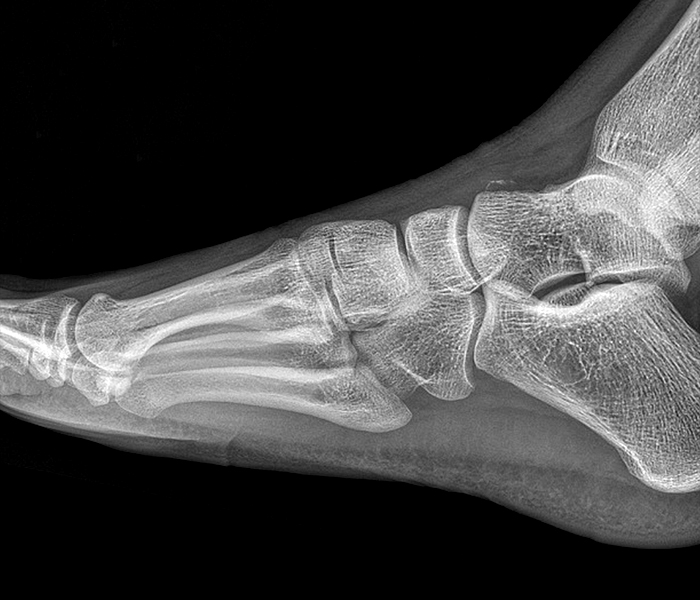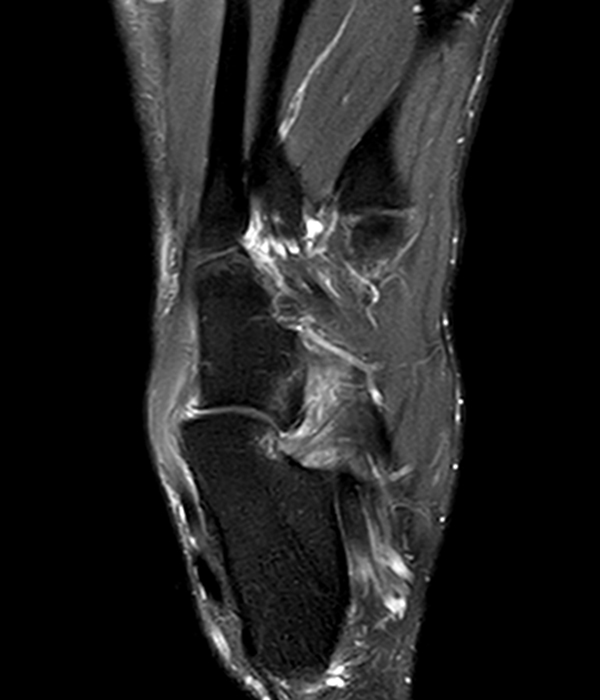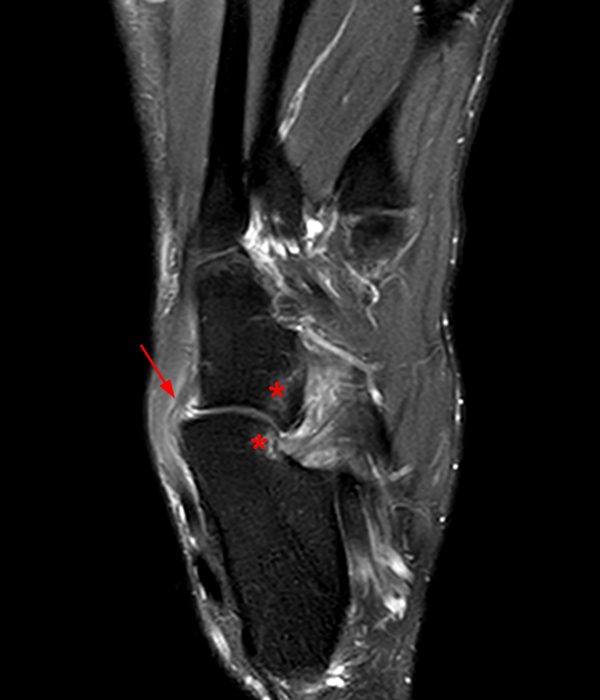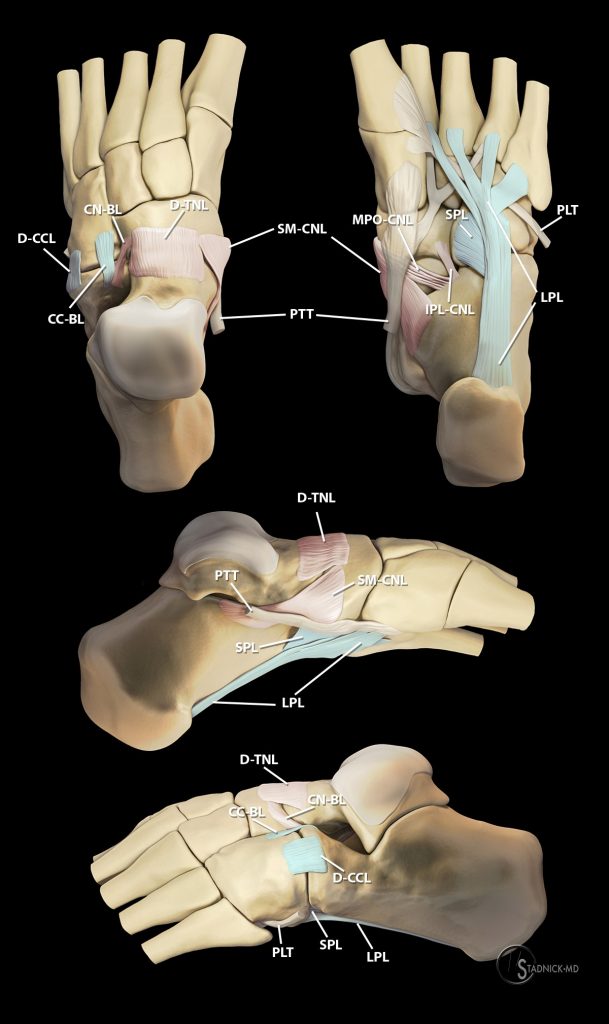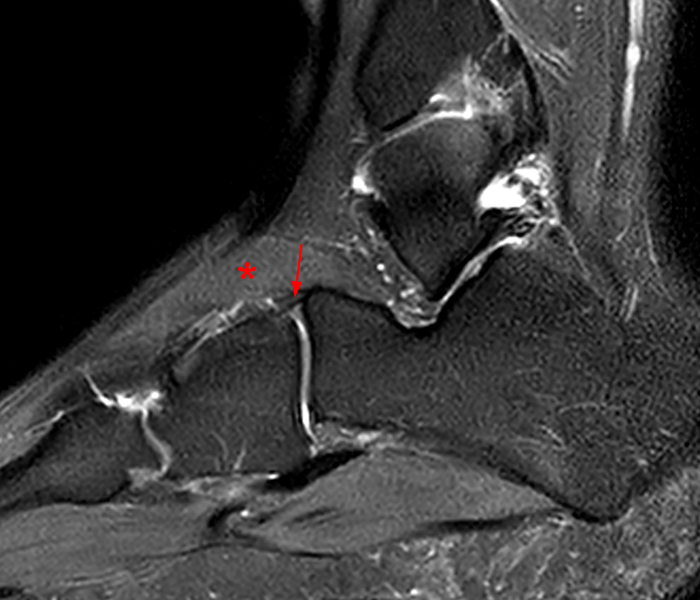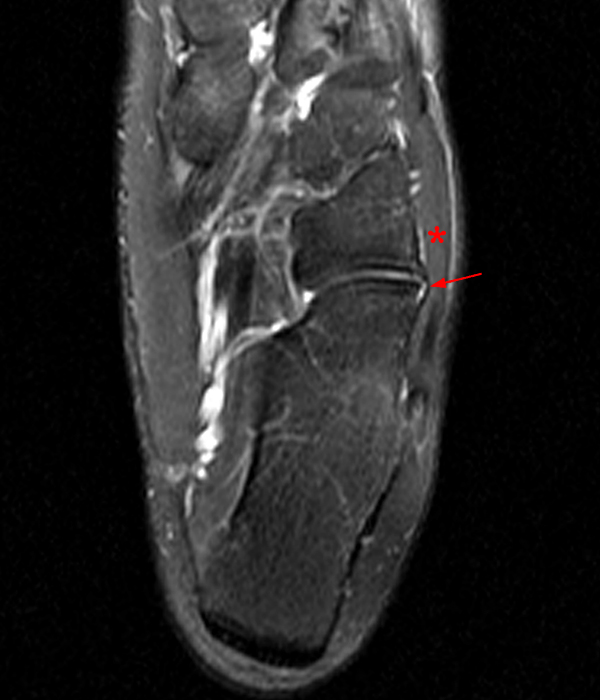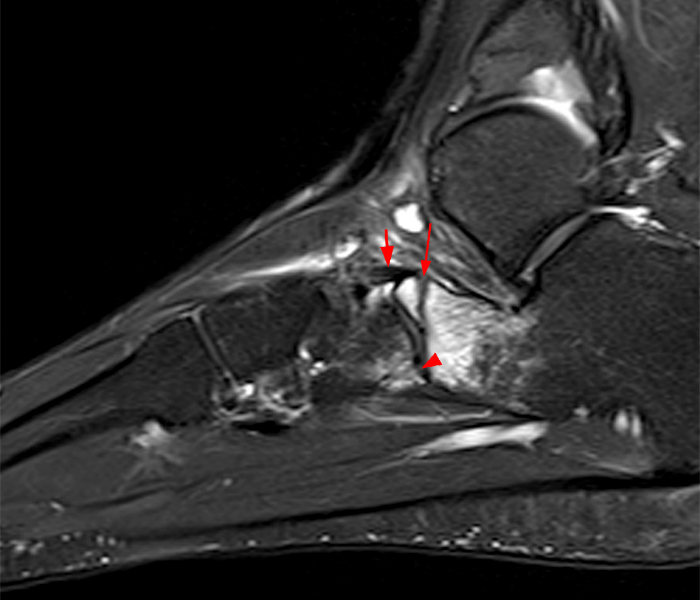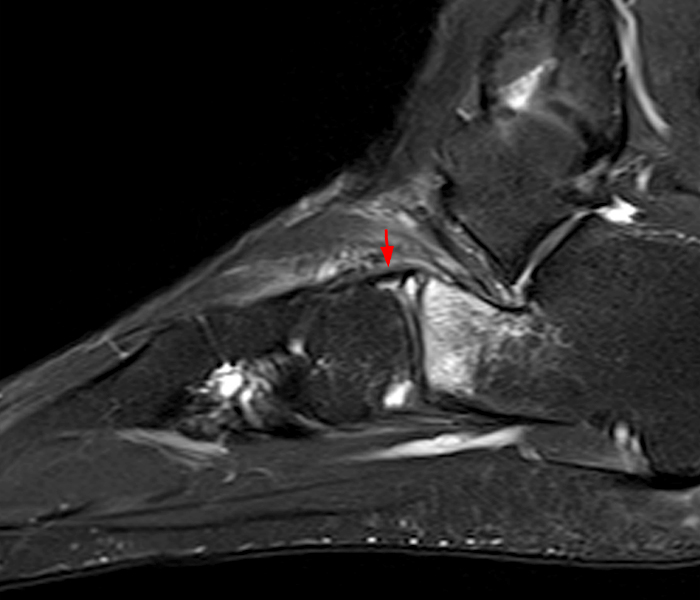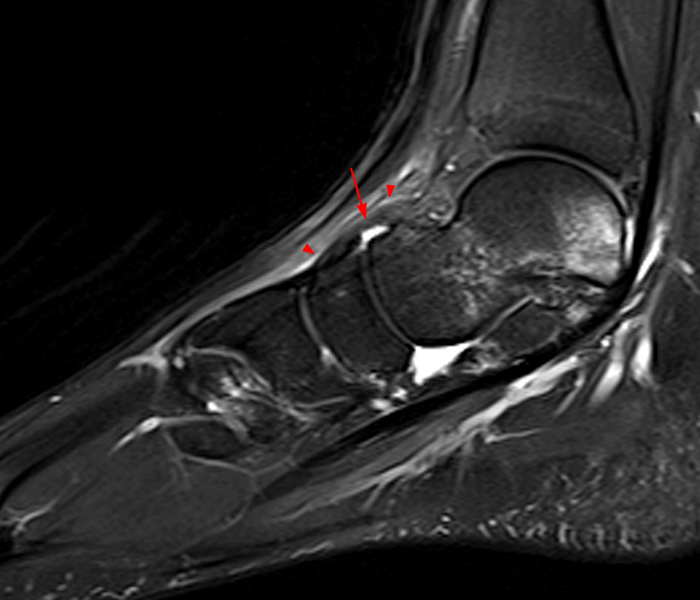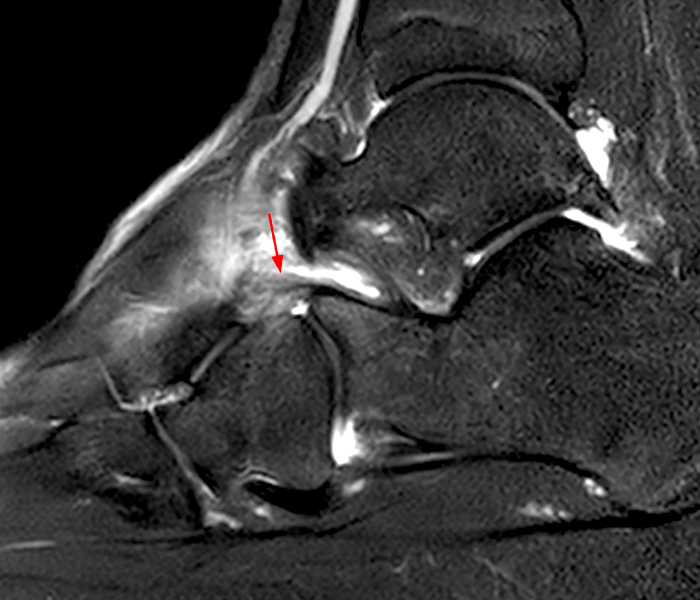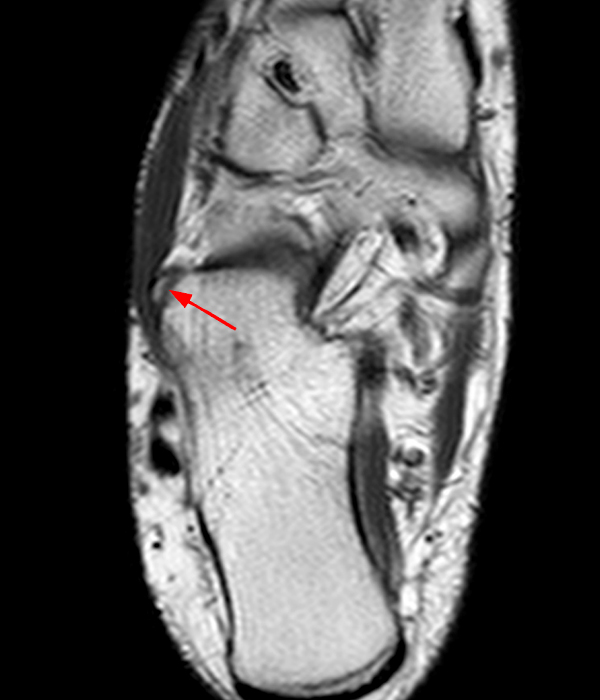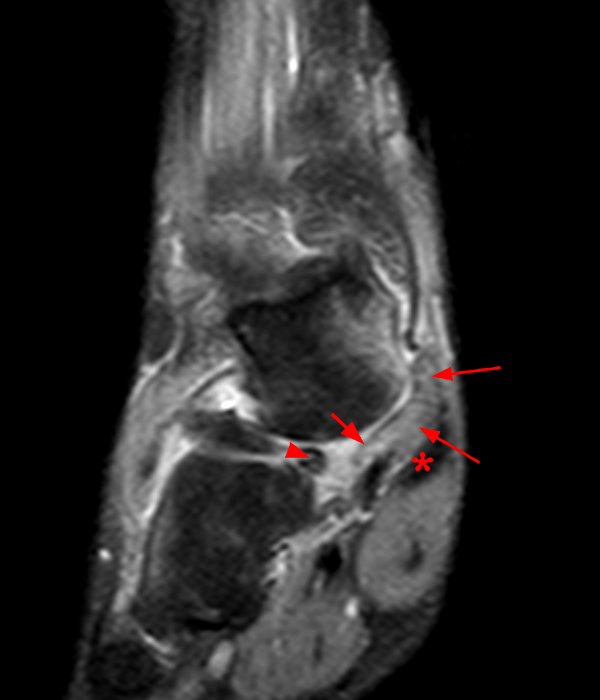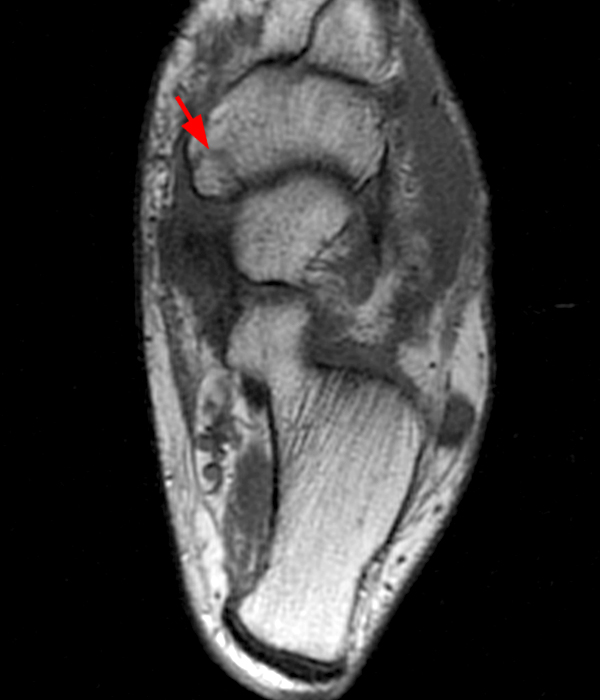Clinical History:
A 30 year-old male presents with pain in the midfoot following a twisting injury to the ankle. A lateral radiograph of the foot is provided [Figure 1A] with sagittal fat-suppressed T2-weighted [Figure 1B, 1C and 1D], and axial fat-suppressed proton-density weighted [Figure 1E] MR images provided. What are the findings? What is the diagnosis?
Findings
Figure 2:
(2A) Lateral radiograph of the foot demonstrates a mildly displaced avulsion fracture from the dorsal talar head (arrow).
(2B) Sagittal T2-weighted fat-suppressed image through the talar neck demonstrates the thin, low signal intensity cortical avulsion fracture (arrow) as well as marked thickening and edema-like signal throughout the dorsal talonavicular ligament (arrowheads).
(2C) Sagittal T2-weighted fat suppressed image more laterally, at the level of the anterior process of the calcaneus. Diffuse edema-like signal is demonstrated within the calcaneonavicular band of the bifurcate ligament (short arrow). Distal ligament fibers are indistinct and possibly discontinuous. A small bone bruise is seen within the distal calcaneus (asterisk).
(2D) Sagittal T2-weighted fat suppressed image slightly more lateral demonstrates diffuse edema-like signal throughout the irregular and discontinuous calcaneocuboid band of the bifurcate ligament (short arrow). The cortical bone is irregular at the dorsal aspect of the cuboid bone proximally suggesting a small cortical avulsion fracture (arrowhead).
(2E) Axial proton-density weighted image at the level of the calcaneocuboid joint demonstrates diffuse thickening, interstitial tearing and edema-like signal throughout the dorsal calcaneocuboid ligament (arrow). Also noted are small osseous impaction injuries at the medial margins of the proximal cuboid bone and distal calcaneus (asterisks).
Diagnosis
Acute midtarsal (Chopart) joint sprain with an associated dorsal talar avulsion fracture.
Introduction/Background
Ankle sprains are a very common injury, occurring in approximately 1 of 10,000 people per day in the United States.1 Injury to the lateral collateral ligaments of the ankle is the most common manifestation of this injury pattern. However, injury to the ligaments at the midtarsal or Chopart joint, affecting the talonavicular and calcaneocuboid joints, is a less recognized yet commonly associated injury.2
An isolated midtarsal sprain is a relatively uncommon injury, reported to occur in only 5.5% of ankle sprains.3,4 However, more recent reports indicate that midtarsal sprains are more common, occurring in up to 33% of inversion injuries of the ankle.5 The wide range in estimates of midtarsal sprain are likely explained by several factors. Often the signs and symptoms of Chopart joint injury are mistaken for or masked by lateral collateral ligament injury.6 Therefore, the clinical detection of acute midtarsal sprains requires a high index of suspicion.
The imaging diagnosis of midtarsal sprain is also often overlooked or underappreciated due to radiologists’ lack of familiarity with the relevant anatomy and injury patterns. The more common lateral collateral ligament injuries are more familiar and may overshadow the associated midtarsal sprains.
Accurate diagnosis of midtarsal sprains is important for appropriate clinical management, particularly in patients with persistent pain after non-operatively managed ankle sprains. Some patients with midtarsal sprain if inappropriately treated or returned to weightbearing too soon, may develop cuboid instability, a cause of chronic foot pain.7 Therefore, familiarity with the often difficult diagnosis of midtarsal sprain is important to guide appropriate treatment and to limit potential patient morbidity.
Anatomy
The Chopart joint complex, also known as the midtarsal or transverse tarsal joint, is located between the hindfoot and midfoot and consists of two functionally distinct units: the talocalcaneonavicular (most often simply called the talonavicular) and calcaneocuboid joints. The joint is named after François Chopart, a French surgeon credited with describing and pioneering an anatomically and functionally convenient method for treating gangrene of the foot by disarticulation at the transverse tarsal joint. Although still used today, midtarsal disarticulation results in severe ankle instability as most of the tendons traversing the ankle lose their insertions, causing marked hindfoot malalignment.8 Interestingly, François Charcot was most accomplished as a pioneer of urologic surgery.
The talonavicular joint, as part of the more elastic medial column of the foot, is stabilized by the dorsal talonavicular ligament, the calcaneonavicular component of the bifurcate ligament, and the spring ligament complex consisting of the superomedial, medioplantar oblique and the inferoplantar longitudinal calcaneonavicular ligament. The more stable calcaneocuboid joint, as part of the rigid lateral column of the foot, is stabilized by the dorsal calcaneocuboid ligament, the short and long plantar ligaments, and the calcaneocuboid component of the bifurcate ligament.
Figure 3:
Dorsal, plantar, medial, and lateral 3D renders demonstrate the major stabilizing ligaments of the midfoot. The talonavicular joint is stabilized by the dorsal talonavicular ligament (D-TNL), the calcaneonavicular component of the bifurcate ligament (CN-BL), and the spring ligament complex consisting of the superomedial (SM-CNL), medioplantar oblique (MPO-CNL) and the inferoplantar longitudinal (IPL-CNL) calcaneonavicular ligaments. The calcaneocuboid joint is stabilized by the dorsal calcaneocuboid ligament (D-CCL), the short (SPL)and long (LPL) plantar ligaments, and the calcaneocuboid component of the bifurcate ligament (CC-BL). The posterior tibial (PTT) and peroneus longus (PLT) tendons are also labeled.
Talonavicular Joint
The talonavicular joint is an arthrodial joint formed by the convex articular surface of the talar head, the concave posterior surface of the navicular bone and the talar facets of the anterior calcaneus. The ball-and-socket arrangement of the joint has been likened to the hip joint, earning it the nickname “coxa pedis”.9
The talonavicular joint has a continuous joint capsule which contains several ligaments. The dorsal talonavicular ligament is a broad capsular thickening, originating from the dorsal talar neck with a broad insertion to the dorsal, medial and lateral aspects of the navicular bone. The dorsal talonavicular ligament is routinely visualized on sagittal MR images. [Figure 4A] The ligament is frequently thickened, which is thought to be a clinically insignificant finding, reflecting adaptive biomechanical changes related to traction during normal gait.8
The spring ligament complex, also called the plantar calcaneonavicular ligament complex, is composed of three parts: the superomedial, medioplantar oblique, and the inferoplantar longitudinal bands. The superomedial component arises from the anterior margin of the sustentaculum tali and inserts onto the navicular tuberosity and the tibiospring portion of the deltoid ligament. The superomedial component is best seen in the coronal and axial planes at the level of the talonavicular joint and is located between the medial talar head and the posterior tibial tendon. [Figure 4B]
The medioplantar oblique component originates from the coronoid fossa of the calcaneus and extends medially to insert on the medial navicular bone. The thickest of the three components is the inferoplantar longitudinal ligament. This also originates from the coronoid fossa of the calcaneus and extends more laterally, inserting on the plantar navicular beak. Both plantar components are best seen on either axial or oblique axial images. [Figure 4C]
The calcaneonavicular component of the Y-shaped bifurcate ligament extends medially from the dorsolateral aspect of the anterior process of the calcaneus, just distal to the origin of the extensor digitorum brevis muscle, to the dorsolateral aspect of the navicular bone. The calcaneonavicular component of the bifurcate ligament is nearly always seen on sagittal images as a thin, low-signal-intensity structure extending from the anterior process of the calcaneus. The navicular insertion is rarely seen due to the oblique orientation of the ligament. [Figure 4D]
Figure 4:
(4A) Sagittal T2-weighted fat suppressed images demonstrate the varied normal appearance of the talonavicular ligament. On the left, a normal talonavicular ligament is thin (arrow). The image on the right is also in an asymptomatic patient with a mildly thickened talonavicular ligament (arrow). This is felt to be related to changes related to traction during normal gait.
(4B) Coronal proton density weighted fat suppressed image shows the superomedial component of the spring ligament (arrow), continuous with the tibiospring band of the deltoid ligament (arrowheads).
(4C) Axial T2-weighted image demonstrates the medioplantar oblique (arrow) and inferoplantar longitudinal (short arrow) bands of the spring ligament.
(4D) Sagittal T2-weighted fat suppressed image demonstrates the calcaneonavicular band of the bifurcate ligament (arrow). The more superior short plantar ligament (arrowheads) is seen with the more inferior long plantar ligament beneath it (short arrows).
(4E) Sagittal T2- weighted fat suppressed image slightly more lateral than in Figure 4D demonstrates the calcaneocuboid band of the bifurcate ligament (arrow) and the overlying extensor digitorum brevis muscle (asterisk).
(4F) Axial T2-weighted fat suppressed image demonstrates the dorsal calcaneocuboid ligament (arrow) and the closely associated extensor digitorum brevis muscle (asterisk).
Calcaneocuboid Joint
The calcaneocuboid joint is a modified saddle-type joint. The anterior articular surface of the calcaneus is convex transversely and concave vertically. This articulates with the proximal surface of the cuboid bone which has a complementary articular surface. With this configuration, the calcaneocuboid joint is one of the least mobile in the foot, helping to stabilize the midfoot during gait.10
The calcaneocuboid component of the bifurcate ligament, also called the medial calcaneocuboid ligament, arises from the anterior process of the calcaneus, just medial to the origin of the dorsal calcaneocuboid ligament and inserts on the dorsomedial aspect of the cuboid bone. This forms the lateral arm of the Y-shaped bifurcate ligament. This ligament is typically seen on sagittal images, arising just lateral to the calcaneonavicular band of the bifurcate ligament. [Figure 4E] The dorsal calcaneocuboid ligament and the calcaneocuboid component of the bifurcate ligament may be continuous and can be difficult to distinguish from each other.5
The calcaneocuboid joint capsule is reinforced dorsally and laterally by the dorsal calcaneocuboid ligament. This arises from the anterolateral calcaneus, lateral to the origin of the bifurcate ligament, and extends anteriorly and medially to insert on the dorsolateral aspect of the cuboid bone. The dorsal calcaneocuboid ligament often has multiple slips and is subject to anatomic variation. [Figure 4F] An accessory lateral band or capsular thickening along the superior third of the lateral margin of the calcaneocuboid joint is the most common variant, occurring in up to 60% of patients.11
The dorsal calcaneocuboid ligament may be closely applied to the dorsal aspect of the joint, blending with the adjacent extensor digitorum brevis muscle, and thus can be the most difficult of the midtarsal ligaments to identify with sagittal MR imaging. It can rarely be visualized on the two most lateral sagittal sections on which the anterior process of the calcaneus and the dorsolateral calcaneonavicular joint are visualized. However, the distal lateral extension of the ligament, via an accessory lateral band, is commonly seen on axial MR images, extending from the calcaneus to the cuboid bone, approximately 5mm distal to the calcaneocuboid joint.5, 11 [Figure 4F]
The long and short plantar ligaments are sometimes referred to together as the plantar or inferior calcaneocuboid ligament. These stabilize the plantar and medial aspects of the joint. The more superficial long plantar ligament originates along the plantar surface of the calcaneus with two bands present in most patients, one deep lateral band projecting to the plantar cuboid bone and one superficial medial band that fans out to attach at the plantar aspects of the second through fifth metatarsal bases.12
The bilaminar short plantar ligament takes a shorter course, with a more anterior origin on the plantar calcaneus and a more proximal insertion on the plantar aspect of the cuboid bone. The short plantar ligament may blend with and reinforce the calcaneocuboid joint capsule. Both the long and short plantar ligaments are well seen on ankle MR imaging, best identified on axial and sagittal images. Along the plantar aspect of the calcaneocuboid joint, the short plantar ligament lies deep and slightly medial to the long plantar ligament. [Figure 4D]
While not directly reinforcing the calcaneocuboid joint, the extensor digitorum brevis muscle overlies the dorsal calcaneocuboid ligament and originates from the dorsolateral surface of the anterior calcaneus, just posterior to the bifurcate ligament and dorsal calcaneocuboid ligament origins. It is clearly seen on axial MR images as a flat muscle overlying the lateral aspect of the calcaneocuboid joint. [Figure 4E, 4F]
Clinical Presentation and Pathomechanics
Midtarsal sprains reflect a spectrum of injuries resulting from low-energy trauma to the Chopart joint complex and include both soft-tissue capsuloligamentous injuries and osseous injuries, including ligament sprains or tears, as well as avulsion or impaction fractures, depending on the severity and mechanism of injury. Although midtarsal sprains most commonly result from ankle inversion, eversion injuries are also possible. Each mechanism of injury results in a distinct injury pattern and recognition of these patterns is important for radiologists to provide a unified, accurate diagnosis of a midtarsal sprain.
Inversion Midtarsal Sprains
Most midtarsal sprains are thought to occur as a result of an inversion injury, resulting in distraction forces across the lateral and dorsolateral aspects of the calcaneocuboid joint2, 4 and, if the magnitude of forces involved are sufficiently severe, impaction along the medial column of the foot. Distraction injuries often result in avulsion fractures in combination with a tear or sprain of the ligament stabilizing the joint. Impaction injuries frequently cause marrow contusion, osteochondral injury, or impaction fractures at the involved osseous surfaces; occasionally, ligamentous contusion can also accompany impaction injuries.
Common injuries in this setting include avulsion of the dorsal calcaneocuboid ligament and calcaneocuboid component of the bifurcate ligament as well as extensor digitorum brevis origin avulsion. Impaction injuries medially may produce contusions or fractures of the talar head and navicular body. Occasionally, because of its complex saddle shape, the calcaneocuboid joint may suffer distraction forces laterally and impaction forces medially. Furthermore, distraction forces across the Chopart joint complex may cause avulsions of the plantar components of the spring ligament. When ankle inversion is accompanied by plantar flexion (as can occur while wearing high-heeled shoes), distraction forces propagate dorsally through the talonavicular joint, often causing dorsal talonavicular ligament avulsion. Distraction forces at the medial calcaneocuboid joint may also produce joint capsule and short plantar ligament avulsion injuries.
Eversion Midtarsal Sprains
Although a less common injury mechanism, ankle eversion can also result in midtarsal sprains. The distinguishing feature of this injury is the compressive impaction (instead of distraction) force at the lateral aspect of the calcaneocuboid joint, producing impaction fractures of the anterior process of the calcaneus and posterolateral cuboid, referred to as “nutcracker” injuries.13 [Figure 5A, 5B] These impaction fractures are often comminuted and depressed. Distraction forces medially can cause navicular tuberosity avulsion fractures due to traction by the posterior tibial tendon.
Figure 5:
Sagittal T2-weighted fat suppressed image of the foot (5A) obtained in a 21 year-old male following a fall. A mildly displaced fracture involves the anterior process of the calcaneus (arrow) with a small impaction fracture at the proximal aspect of the cuboid bone (arrowhead), the so-called ‘nutcracker injury’. The intact calcaneonavicular band of the bifurcate ligament is also demonstrated (short arrow). Sagittal T2-weighted fat suppressed image obtained slightly more lateral (5B) again shows the osseous impaction injuries. The intact calcaneocuboid band of the bifurcate ligament is demonstrated (short arrow).
Evaluation
MR Imaging
Prolonged pain after non-operative management of a lateral ankle sprain is a common indication for MRI evaluation, to evaluate for a more extensive injury than initially suspected. MRI is essential to evaluate both the bones and soft-tissue structures about the ankle and foot. While tiny avulsion fractures may be better detected with plain radiography or CT, MRI is optimal for directly visualizing the midtarsal ligaments and detecting associated foci of marrow edema related to avulsion, impaction, or contusion. One study found that only 48% of calcaneocuboid injuries and 50% of talonavicular injuries were seen at radiography when compared with MRI.14
Conversely, avulsion-related bone marrow edema is usually subtle; therefore, MRI in this setting should be interpreted in combination with radiography or CT. Contusion-related bone marrow edema is more obvious at MRI. Consequently, the high sensitivity of MRI for detecting marrow edema can aid in detecting nondisplaced fractures and impaction injuries, which can easily be missed on radiographs.
Midtarsal sprains are typically multiligamentous; therefore, any of the Chopart joint ligaments are subject to injury and should be carefully evaluated.5 As with ligaments elsewhere in the body, midtarsal ligament sprains are best seen on fluid-sensitive fat-suppressed proton density or T2-weighted images, appearing as ligament discontinuity or edema. Partial tear or sprain results in thickening or attenuation of the ligament, with either surrounding or intrasubstance edema. [Figure 6]
Figure 6:
(6A) Sagittal T2-weighted fat suppressed image of the foot obtained in a 21 year-old male following a fall. The talonavicular ligament is diffusely thickened with increased signal intensity within the ligament (arrow) as well as fluid-like signal intensity adjacent to the ligament (arrowheads). The appearance is compatible with a mild to moderate ligament sprain. This ligament can be thickened in asymptomatic patients due to the biomechanical stress at the joint related to normal gait. The presence of fluid-like signal within and adjacent to the ligament is needed to confidently diagnose a sprain.
(6B) Sagittal T2-weighted fat suppressed image in a 14 year-old male following an injury playing football. The calcaneonavicular band of the bifurcate ligament is diffusely thickened and is of increased signal intensity (arrow). Soft tissue fluid-like signal and adjacent joint effusions help to outline the ligament. This appearance is consistent with a moderate ligament sprain.
Complete disruption of a ligament is usually obvious, appearing as complete discontinuity, often with a fluid-filled defect at the site of disruption. [Figure 7A, 7B]
Figure 7:
Sagittal T2-weighted fat suppressed image (7A) obtained just lateral to the image in Figure 6B. A distal tear is demonstrated involving the cuboid insertion of the calcaneocuboid band of the bifurcate ligament (arrow). Note the small fluid-filled defect at the site of ligament disruption. This reflects a grade 3 sprain or ligament tear. Axial T2-weighted image (7B) in the same patient demonstrates a complete proximal disruption of the dorsal calcaneocuboid ligament from its’ calcaneal origin (arrow). The ligament has a wavy contour and is displaced slightly distally. Also note the associated muscle strain injury with increased signal intensity involving the adjacent extensor digitorum brevis muscle (arrowheads).
Midtarsal sprains can be purely ligamentous but are often accompanied by avulsions from osseous attachment sites or contusions at common sites of impaction, depending on the mechanism of trauma. [Figure 2B, 8] MR imaging injury patterns can be subdivided into (a) lateral distraction with medial compression, (b) dorsal distraction, and (c) medial distraction with lateral compression.
Figure 8:
Axial inversion recovery image in a 55 year-old male with foot pain following an injury. A tiny cortical avulsion fracture is seen at the distal margin of the cuboid bone laterally involving the origin of the dorsal calcaneocuboid ligament. (arrow) Adjacent fluid-like signal nicely outlines the ligament. Cortical avulsion fractures representing ligament avulsion injuries are often subtle. The associated bone marrow edema (asterisk) aids in detection.
Lateral ligamentous distraction, typical of inversion injuries, most commonly results in dorsal calcaneocuboid and bifurcate ligament sprains. Extensor digitorum brevis origin avulsion or muscle strain and lateral calcaneocuboid joint capsule avulsion may also be seen. [Figure 9A, 9B] The normal calcaneonavicular component of the bifurcate ligament is almost always clearly seen; therefore, an absent or indistinct ligament should prompt a higher degree of suspicion for midtarsal sprain. On the other hand, a normal dorsal calcaneocuboid ligament and calcaneocuboid component of the bifurcate ligament are more difficult to reliably detect at MR imaging. Therefore, sprain of these ligaments should be diagnosed with careful reliance on secondary signs such as periligamentous soft tissue edema and marrow edema at their attachment sites. The search for small foci of marrow edema related to lateral distraction should include careful evaluation of the anterior process of the calcaneus and the dorsolateral cuboid (indicating avulsions of the dorsal calcaneocuboid ligament, the calcaneocuboid component of the bifurcate ligament, and possibly the extensor digitorum brevis muscle), as well as the lateral and plantar aspects of the calcaneocuboid joint (capsule and plantar ligaments). Associated compressive forces at the medial calcaneocuboid joint may produce contusions of the plantar talar head, navicular body, and medial calcaneocuboid joint margins.
Figure 9:
Coronal proton-density weighted image in a 46 year-old woman following a twisting injury and fall (9A). Marrow edema and cortical irregularity are seen at the lateral margin of the distal calcaneus involving the origin of the extensor digitorum brevis muscle (arrow). Edema-like signal is also seen within the proximal muscle fibers (arrowheads). The appearance reflects an avulsion fracture at the muscle origin with associated muscle strain injury in this patient with a lateral distraction injury. Axial T1-weighted image (9B) in the same patient better demonstrates the minimally displaced cortical avulsion fracture (arrow). T1-weighted images often best demonstrate osseous anatomy.
Since inversion injury is often associated with plantar flexion, dorsal distraction at the talonavicular joint may result in dorsal talonavicular ligament sprain [Figure 2B, 6A] It is important to evaluate the entire width of this broad ligament, as partial tears are possible. Edema in the dorsal subcutaneous soft tissues overlying the ligament further supports the diagnosis. Avulsion-related marrow edema can be subtle, but will be found at the dorsal talar head, proximal aspect of the navicular bone, or both.
Finally, medial ligamentous distraction, seen in the less-common eversion mechanism, may produce plantar or superomedial spring ligament sprains [Figure 10A, 10B], best evaluated on fluid-sensitive axial and coronal images, respectively. Short plantar ligament sprains may involve the closely applied medial calcaneocuboid joint capsule, and avulsion-related marrow edema appears at the medial margins of the calcaneocuboid joint. Spring ligament avulsions, uncommonly seen, may produce focal marrow edema at the sustentaculum tali or navicular tuberosity. Avulsion fractures of the navicular tuberosity, while usually seen at radiography or CT, may be first suspected at MRI by the presence of marrow edema in that location or by cortical disruption [Figure 10C]. Associated lateral compression forces result in osseous impaction at the lateral calcaneocuboid joint, producing comminuted intra-articular fractures.
Figure 10:
Axial T2-weighted image(10A) in a 32 year-old female patient with pain in the arch of the foot with progressive pain and swelling following an injury. Edema-like signal and ligament fiber irregularity are demonstrated within the medioplantar oblique band of the spring ligament (short arrows) reflecting a sprain. The more lateral inferoplantar longitudinal band of the spring ligament remains intact (arrowheads). Coronal proton-density weighted image (10B) in the same patient demonstrates disruption of the superomedial component of the spring ligament near its calcaneal insertion (arrows) deep to the posterior tibial tendon (asterisk). Axial T1-weighted image obtained in a 35yo male (10C) with pain following an injury. A small non-displaced avulsion fracture involves the navicular tuberosity. (short arrow)
Treatment and Prognosis
Identifying midtarsal sprains on MR imaging is important, because the injury is believed to be a significant cause of Chopart joint instability, cuboid instability, and chronic lateral foot pain, particularly among athletes, who may prematurely return to active weight-bearing. Non-operative management of midtarsal sprains may resemble that for lateral ankle sprains, with rest, ice, compression and elevation the primary treatment along with a controlled-motion walking boot or aircast splint. However, a recent report recommends more aggressive immobilization using a short leg cast for 6–8 weeks followed by return to weight-bearing with a soft brace for 6 weeks.15
The consequences of immobilization as a treatment of midtarsal sprains have not been systematically studied, but it is recognized that a subset of patients will not improve with non-operative management and may require surgical intervention. Although refractory midfoot pain or secondary osteoarthritis from Chopart fracture-dislocations have been treated with arthrodesis, several new surgical procedures emerging within the last decade offer anatomic stabilization of the midtarsal joint by primary tendon repair or graft reconstruction.3, 4, 16, 17 These various treatment options must be studied prospectively to determine their long-term clinical outcome. Central to such a study is the ability to recognize and reliably diagnose the MR imaging appearance of midtarsal sprains.
Conclusion
Midtarsal sprains are more common than previously realized, but are frequently overlooked in the setting of acute lateral ankle sprains. Delayed diagnosis of midtarsal sprains may lead to dysfunction, prolonged pain, and instability. Therefore, it is important for both clinicians and radiologists to be familiar with the patterns of injury and maintain a high degree of suspicion, particularly in patients imaged in the acute or subacute setting following presumed lateral ankle sprains. This may allow a timely diagnosis of this injury and allow appropriate treatment to be initiated.
References
- Doherty C, Delahunt E, Caulfield B, Hertel J, Ryan J, Bleakley C. The incidence and prevalence of ankle sprain injury: a systematic review and meta-analysis of prospective epidemiological studies. Sports Med 2014; 4 4:123 –140 ↩
- Andermahr J, Helling HJ, Maintz D, Monig S, Koebke J, Rehm KE. The injury of the calcaneocuboid ligaments. Foot Ankle Int 2000; 21:379–384 ↩
- Søndergaard L, Konradsen L, Holmer P, Jorgensen LN, Nielsen PT. Acute midtarsal sprains: frequency and course of recovery. Foot Ankle Int 1996; 17:195–199 ↩
- Main BJ, Jowett RL. Injuries of the midtarsal joint. J Bone Joint Surg Br 1975; 57:89–97 ↩
- Walter WR, Hirschmann A, Alaia EF, Garwood ER, Rosenberg ZS. Journal Club: MRI Evaluation of Midtarsal (Chopart) Sprain in the Setting of Acute Ankle Injury. AJR Am J Roentgenol 2018; 210:386-395 ↩
- van Dorp KB, de Vries MR, van der Elst M, Schepers T. Chopart joint injury: a study of out-come and morbidity. J Foot Ankle Surg 2010; 49:541–545 ↩
- Durall CJ. Examination and treatment of cuboid syndrome: a literature review. Sports Health 2011; 3:514 –519 ↩
- Walter WR, Hirschmann A, Alaia EF, Tafur,M, Rosenberg ZS. Normal Anatomy and Traumatic Injury of the Midtarsal (Chopart) Joint Complex: An Imaging Primer. RadioGraphics 2019; 39:136-152 ↩
- Pisani G. “Coxa pedis” today. Foot Ankle Surg 2016;22(2):78–84 ↩
- Sarrafian SK. Biomechanics of the subtalar joint complex. Clin Orthop Relat Res 1993; 290:17–26 ↩
- Dorn-Lange NV, Nauck T, Lohrer H, Arentz S, Konerding MA. Morphology of the dorsal and lateral calcaneocuboid ligaments. Foot Ankle Int 2008;29(9):942–949 ↩
- Ward KA, Soames RW. Morphology of the plantar calcaneocuboid ligaments. Foot Ankle Int 1997;18(10):649–653 ↩
- Hermel MB, Gershon-Cohen J. The nutcracker fracture of the cuboid by indirect violence. Radiology 1953; 60:850–854 ↩
- Hirschmann A, Walter WR, Alaia EF, Garwood E, Amsler F, Rosenberg ZS. Acute fracture of the anterior process of calcaneus: does it herald a more advanced injury to Chopart joint? AJR Am J Roentgenol 2018;210(5):1123–1130 ↩
- Kutaish H, Stern R, Drittenbass L, Assal M. Injuries to the Chopart joint complex: a current review. Eur J Orthop Surg Traumatol 2017; 27:425–431 ↩
- Golanó P, Vega J, de Leeuw PA, et al. Anatomy of the ankle ligaments: a pictorial essay. Knee Surg Sports Traumatol Arthrosc 2016; 24:944–956 ↩
- Muhle C, Frank LR, Rand T, et al. Collateral liga-ments of the ankle: high-resolution MR imaging with a local gradient coil and anatomic correlation in cadavers. RadioGraphics 1999; 19:673– 683 ↩

